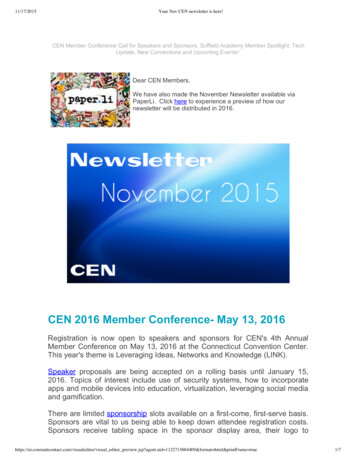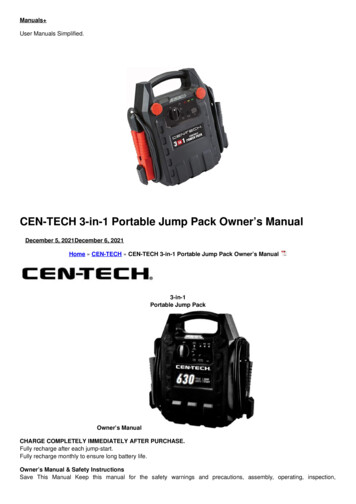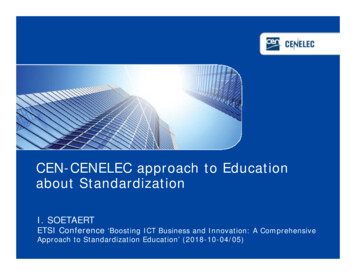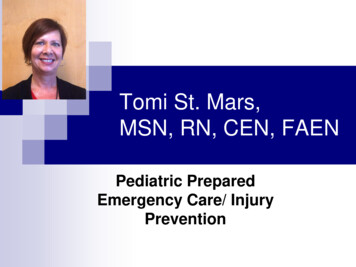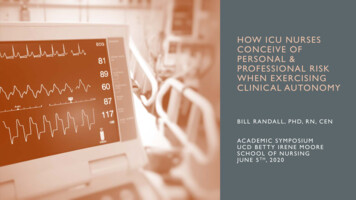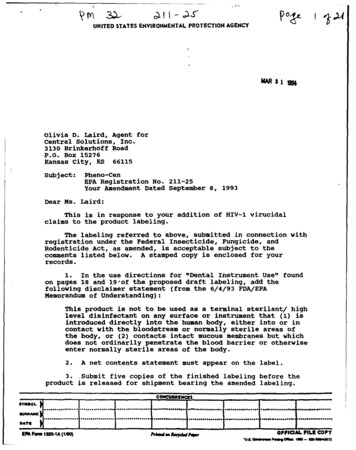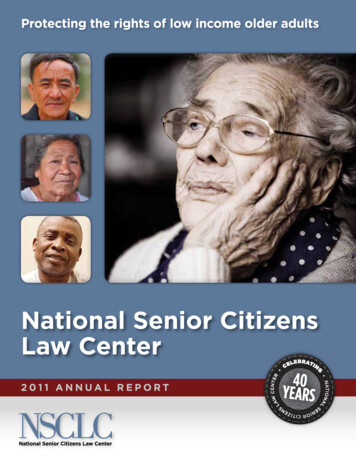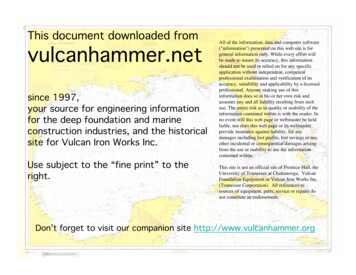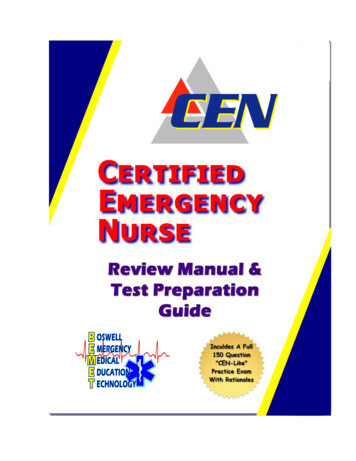
Transcription
CEN(Certified Emergency Nurse)Review Manual &Course Materialwww.BEMETweb.comMark W BoswellMSN, FNP-BC, CEN, CFRN, CTRN, TCRN, CPEN,SCRN, NREMT-P, EMT-T, W-EMT
TABLE OF CONTENTSClinical Section IOrthopedic EmergenciesIntegumentary EmergenciesSelected Trauma.1Clinical Section IISubstance Abuse EmergenciesToxicological EmergenciesEnvironmental Emergencies.15Clinical Section IIIShock & Multi-system Emergencies.33Clinical Section IVRespiratory Emergencies.43Clinical Section VObstetrical EmergenciesFemale/Male GU Emergencies.59Clinical Section VIGeneral Medical Emergencies.79Clinical Section VIICardiovascular Emergencies.101Clinical Section VIIINeurological Emergencies.115Clinical Section IXAbdominal Emergencies.139Clinical Section XOcular/Maxilo-Facial and selected ENT Emergencies.153
ORTHOPEDIC, INTEGUMENTARY &SELECTED TRAUMASELECTED al Tunnel SyndromeCompartment SyndromeContusionCostochondritisForeign BodiesFracture/DislocationABRASIONSInjury d/t dermis/epidermisFalls, scrapesGood wound care essential to avoid“tattooing effect” from debrisShould be cleaned in 6-8 hoursDiabetics, Immune compromised at riskWound cultures?Clean, Debride; Betadine, H202, NSPain medsTetanusNon stick dressing, porousAMPUTATIONSAvoid tunnel visionABCDsWithout coolingDigits 12 hoursOthers 6 hoursWith coolingDigits possible up 24 hoursProximal to wrist 12 hoursHealing/reattachment pointsChildren 50 y.o. –peripheral vascular diseaseFunctional vs hindranceCan they complete rehab?Important: note time of injuryControl bleeding firstSimple dsg up to tourniquetSplint, elevateCopious irrigation; NS onlyWrap stump with NS gauzeAmputation – cover dry sterile gauzePlace in bagPlace that bag into a bag of iceBoswell Emergency Medical Education Technology 1
Pain meds, antibiotics, tetanusPossible transfer outAVULSIONSCan’t approximate tissue edgesCommon in fingersHemostasis sometimes difficultSmall ones: delayed secondary healingLarge: surgicalSterile NS dsgVaseline/xeroform goodConsider metal/protective splintBITES AND STINGSMay cause: Punctures/lacerations,Anaphylaxis, infection, disease xmissionDog & Cat BitesLacerations/puncturePossible crush injury (dog)90% of ER bites are dogsCat bites hi-risk infection (pasturella)Dogs/cats – not likely rabidConsider rabid: bats, foxes, raccoonsKnown vs unknown animalProvoked?Gen appearanceThoroughly wash, irrigateSutures /Pain meds/sedationAntibiotics/tetanusRabies prophylaxisRIG (Rabies Immune Globulin)immediateprotectionSnakesThousands annuallyOnly 10-15 mortalTwo familiesViperidae (vipers, rattlesnakes)Elapidae (coral snake)Hands, feet, face injuries20% “dry” bitesCroatalide envenomation:Rapid onset burning pain and edemaEcchymosis ensues and spreadsVenom enzymes causeLocal tissue damage, edemaHypotension, coagulopathy, shock, death 2 CEN Review Course
Elapidae envenom:Little or no local reactionSx onset possible delayed up to 13 hoursPt w/parasthesias, burning at local site athigher risk for neuromuscular blockageand resp compromiseSnake identificationPit viper: triangular head, pit between eyes,elliptical pupilsCoral snakes: red, yellow, black bands;black head; “red on yellow kill a fellow”Bite location/TimeS/Sx: weakness, parasthesia, diplopia,muscle pain, N/V/D, CP/SOBPit viper: fang marksCoral snake: tiny punctures, “chew”Both: edema, ecchymosis, vesiclesCoags, Fibrin degradation and split products(FDP, FSP),U/A-myoglobinElevate slightly, immobilizeCardiac, Sp02Routine wound careControversy over coolingAntivenom: give within 4 hours of biteDose depends on degree of envenomCroFab requires no skin testingInsects (Bees, Wasps, Ants)Concern: anaphylaxisOral facial edema, respiratory, urticariaHx Asthma?Prior sting allergy/reaction?Stridor, cough, hoarseness?Stinger still in?Remove stinger w/scraping motionIce, baking soda, aloe vera to ?TetanusPt educationEpi-PenPrevention: insect repellentBoswell Emergency Medical Education Technology 3
CARPAL TUNNEL SYNDROMEMedian nerve entrapmentWomen: men 2:1Pregnant women d/t fluid retentionRepetitive motionsPain, paresthesias; median nerve areaTinel’s Sign: percussion/tapping on median nerve;if tingling felt in hand diagnosticPhalen's Sign:X-rays r/o othersElectro-myelography (EMG) - Gold StandardIce/Elevate/Non Steroidal anti-inflammatory(NSAIDS)Wrist splint(s)Orthopedics, Occupational Med ReferralCOMPARTMENT SYNDROMETrauma, Crush injuries, High pressure injectionsburnsLower leg, forearmAlso d/t splints, casts, Pneumatic Anti-ShockGarments (PASG), Military Anti-ShockTrousers (MAST)First affects low-flow systemLater arterial flow and nerves affected5 P’s: Pain, Pallor, Paresthesias, Paralysis, PulsePMHx: Hemophilia?U/A myoglobinSerum MB, CPK, CBC, CoagsDoppler U/S?Compartment pressure monitoring10 mmhg or less: normal/OK30-40 mmhg: possible fasciotomyElevate slightly, don’t use IcePain medsCONTUSIONS/BRUISES/HEMATOMASA closed wound with ruptured blood vesselsSx: swelling, discoloration, tendernessPMHx: check for bleeding disorders ormeds that prolong bleedingConsider labsPossible x-raysIce/elevate/splint 4 CEN Review Course
COSTOCHONDRITISInflammatory chest wall painPossibly r/t exertion/strainPain similar to AMI or rib Fx’sPain: sharp, pleuriticMUST: consider Coronary disease/Acute MI riskfactors and r/o as indicatedDon’t forget PE, PneumoniaTx: NSAIDs, Muscle relaxers, Narcotics, HeatSPRAINS/STRAINSSprain: LigamentStrain: Muscle/tendonRisk factors:“weekend warriors”Rheumatoid Arthritis (RA), Steroid use/injectionsDiagnostics: Ottawa ankle, knee, foot rulesAchilles rupture: “hit in back of leg” – classicR.I.C.E.: Rest, Ice, Compression, ElevationImmobilizationWt bearing limitationsNSAIDs, NarcsFRACTURESOpen Fx: hi-risk infectionCrush injuries: complicated nutedBEWARE: Tunnel vision!Splint in position foundIce/elevatePain medsPossible sedation/reductionOpen Fx’s:Cover w/sterile NS dsgsClean/irrigate only w/NSWound mgmt, possible culturesAntibiotics/tetanusTraction Splints:Used to stabilize a mid-femur fractionalong it’s long axis using counter-tractionWithout counter-traction it is possible for thespasming muscles or deformity tocompromise the distal neuro-vascularfunction.Boswell Emergency Medical Education Technology 5
Indications:For use in mid- femur fractureContraindicationsConcurrent knee, hip or pelvis injuryLower leg or ankle injuryApplication:Stabilize fracture site, manual tractionSecure splint proximally (ischial tuberosity)Secure splint distally (ankle)Apply mechanical tractionRe-assess distal neuro-vascularDISLOCATIONSConsidered an EMERGENCY d/t potential nervedamage, blood vessel damage or tissueischemiaKNEE: (not patella) immediate reductionANKLE: usually needs surgery; prompt reductionSHOULDER: needs prompt reductionPossible avascular necrosis (AVN)RADIAL HEAD DISLOCATIONNursemaid’s elbowd/t sudden jerk or pullingRefuses to use armCan flex and extend elbow, won’t pronate/supinatePossibly no deformity and no significant painMay be recurrent up to 5 years oldBURSITISInflammation of bursal sacAcute (trauma/infection) or chronicMust r/o infectionCommon: shoulder, elbow, kneeRed, warm, swollen, tenderAspirationX-rays, CBC, Sed Rate (ESR), C-reactive protein(CRP), Basic metabolicTx: NSAIDs, NarcsIce/elevationSplinting/compressive dsgs 6 CEN Review Course
TENDONITISInflammation of tendons or tendon-muscleattachmentsUsually excessive/repetitive stressesCommon: Shoulder, elbow, knee, heelPoint tendernessLook for: swelling, redness, heatMay need to r/o infectionTx: NSAIDs, NarcsSplinting/bracing/ortho-phys therapy referralGOUTCrystal induced arthropathyCrystals trapped in joint spaceD/T inc production or dec. elimination of uric acidThiazide diuretics and purine rich foodsAlso assoc with many autoimmune andmetabolic diseasesMale: Female 9:1Rapid onset (overnight)No Hx traumaMod-severe painHot, red, swollen, EXQUISITELY tenderMust consider infection alsoPoss. IM/IV pain medsX-raysCBC, BMP, ESR, CRP, Uric Acid, Aspiration?Educ: Hydration, Wt LossMeds: NSAIDs, Colchicine, NarcsJOINT EFFUSIONCollection of fluid in joint spaceMost common: kneeAssess for trauma/infectionHx Substance Abuse: septic arthritisHx: Sexually transmitted diseases (STD’s),bleeding disordersConsider cellulitis, goutX-rays r/o Fx’sSwelling, tenderness, fluctuance, ballottmentCheck ROMLabs: CBC, BMP, ESR, CRP, Uric Acid, RapidPlasma Reagen (RPR – for syphilis),Hepatitis profileJoint aspirationImmobilization, IceOrtho referralNSAIDs, Narcs, Steroid injectionBoswell Emergency Medical Education Technology 7
OSTEOMYELITISInfection of the bone and tissuesD/T open wounds, puncture wounds, surgeryExogenous vs hematogenous sourcesHematogenous: skin abscess, Otitis Media (OM),UTI, Pneumonia, abscessed teethStaph AureusPain, fever, malaiseSwelling, redness, warmthPossible Sx of SepsisPMHx: Diabetes, sickle cell, Immune compromisedHx of surgical procedure, fixationIVDU (Intravenous Drug Use)CBC, ESR, CRP, BMP, Blood culturesBone ScanParenteral IV antibiotics long termTransmission precautionsPain medsOrthopedics f/uPUNCTURE WOUNDSCommonlyStepping on nails, tacks, needles, broken glassUsually minimal bleeding and seal off –increasing infection riskNear joints esp. hi-riskPlantar surface through shoe inc risk ofPseudomonas d/t foreign bodyCBC, BMP, X-raysRemove foreign body if presentAssist with opening, debriding, irrigating andpacking if contaminatedAntibiotics, tetanus, pain medsElevate, limit useHome care: warm soapy water soaksShould have wound check follow up madeFOREIGN BODIESMany thingsWood, metal splinters, glass, clothing,(Gun shot wound) GSW fragments,fishhooks etc.Vegetative (organic) items more likely to causeinfection (thorns, wood), need to beremoved 8 CEN Review Course
Diagnostic imagingRoutine wound care externally***Don’t soak if wood embedded***Home care: soaks, elevate, pain meds,antibioticsMISSILE INJURIESPenetrating: GSW, stabs and othersHigh velocity, may cause bony, neurovascularand other injuries remote from thepathForensic considerations; evidenceHi-pressure injection wounds might requiredebridement and extensive irrigationunder anesthesiaX-rays usually indicatedControl local bleeding, elevationRoutine external wound careAssist with debriding, exploring, irrigationLACERATIONSWound mgmt goals:Restore functionRepair tissue integrityMinimize risk of infectionEpithelial cell growth begins as early as6 hours post injuryConcern about areas of flexion/extensionDelayed closure issuesAssess distal CMS/NVSAssess ROM, esp. flex/extensionConsider x-raysControl bleedingClean/irrigate with NS or antiseptic soapDebridementWound closureSutures, staples, Dermabond, Steri-stripsMay need splinting tooWound care instructionsElevate x24-48 hoursIceDressing on x48 hours2-3 day wound check, first dsg changeSunblock for 6mo after suturesBEST prevention for infection is good, thoroughwound cleansing, including hi-pressureNS irrigationBetadine?Boswell Emergency Medical Education Technology 9
SUTURE REMOVAL TIMES:Face 3-5Scalp 5-8Upper extremitiesNon joint: 7-10Joint: 10-12Lower extremitiesThigh 7-10Knee 12-14Lower leg/foot 7-10LOW BACK PAIN (LBP)Usually benign, affecting 60-80% of everyoneConsider 3 groups1)Non-specific LBP 85% cases2) LBP potentially assoc with spinal pathology(stenosis, sciatica, compression Fx)3) LBP potentially assoc with another condition(cancer)Most common causes:Intra-vertebral disk diseaseDisk herniationAvg age of onset: 30-40 y.o.Risk factors:Obesity, body mechanics, lifting, prolongedsitting, poor office furniture, hard floorsurfacesPain: localizes or radiatesAssoc sx: paresthesia, impaired bowel,bladder function, impaired sexualfunctionAssess: gait, posture, point tenderness or diffuse,spasmSensory examFront of thighs: L2Middle/sides lower leg: L4-L5Little toes: S1Deep Tendon Reflexes (DTRs):Grade:0: none,1 below normal,2 average,3 stronger than avg,4 intense 10 CEN Review Course
RED FLAGS:Age under 20 or over 55Non-mechanical painCancer (CA), steroids HIV or other significantpast historyUnwell, wt lossWidespread neurological e.g. bilateral leg signsStructural deformitySaddle anesthesia/sphincter disturbanceX-rays, not routinely unless you suspect FxNSAIDs, Steroids, Muscle Relaxers, NarcoticsEvidence supports a rapid return to function.AndIE: bed rest for 1 day only, thengradual return to normal activity in 2-4daysBoswell Emergency Medical Education Technology 11
QUICK REVIEW(1) Name one Fx commonly assoc withcompartment syndrome?(2) What are late signs of compartmentsyndrome?(3) What is initial nursing intervention for openwound near a Fx?(4) What is the name of inflammation of thesynovial cavity surrounding a joint?(5) Onset of Gout – how long?(6) What two physical examination assessmentsare done Dx carpal tunnel?(7) Which gives immediate protection tetanustoxoid or tetanus immune globulin?(8) What patients need immediate tetanusprotection?ANS:(9) What labs test might help most to diagnosecompartment syndrome?(10) What are some important “rule-out”conditions to do for costochondritis?(11) What age range is a possible “red flag” forlower back pain (LBP)? 12 CEN Review Course
Boswell Emergency Medical Education Technology 13
14 CEN Review Course
SUBSTANCE ABUSE, TOXICOLOGICAL,ENVIRONMENTAL EMERGENCIESOverdose Emergencies/Quick pinesCarbon MonoxideCyanideIronSalicylatesTricyclic antidepressantsACETAMINOPHENIn many OTC productsEasily availableIntentional or unintentionalRapidly absorbed in GI tractMetabolized by liverToxicity causes:CoagulopathiesHepatic necrosis/failureEarly sx: malaise, n/vLate sx: met. Acidosis, RUQ pain,decreased. urine output, jaundice,hypoglycemia, coagulopathy, DIC, sepsisASSESSMENTAcute vs chronicConcurrent ETOH or drug useReason for exposure (intentional vs side effect)PMHXPsych HxETOH HxLiver diseaseEXAMLOCJaundiceRUQ ttpHepatomegalyGI bleedingDIAGNOSTICSSerum APAP 4 hours post-ingestionRumack-Matthew nomogramBoswell Emergency Medical Education Technology 15
CBC, Chemistries, LFT's, CoagsU/A, UPT (urine preg test)Toxicology panelINTERVENTIONSABCs, IV, Cardiac, Pulse Ox PRNNG tube (NGT), lavage possiblePossible admissionMEDICATIONSActivated charcoalN-acetylcysteine (Mucomyst) PO, NGTAcetadote IV (not as effective as PO)BENZODIAZEPINESCNS depressantsMain concern: resp. depressionHigh addiction potentialUsed for sleep/anxietyBenzos not as toxic as barbituratesASSESSMENTAgent ingested, amountsAny co-ingestionsReason (intentional/accidental)PMHXPsych hxSeizure hxEXAMLOC; drowsiness, ataxia, euphoriaHypotension, hypothermiaDysrhythmiasPupillary changesDIAGNOSTICSCBC, ChemistriesU/A, UPTTox panelABGsINTERVENTIONSABC's, IV, Monitor, Pulse Ox PRNPossible RSI if obtundedPossible IVF bolusesAirway: positioning, Naso-pharyngeal (NPA),Oro-pharyngeal (OPA), intubationNGT prnAdmission, dialysis?MEDICATIONSActivated CharcoalRomazicon (Flumazenil); possible seizuresSodium Bicarb: to alkalinizeVasopressors 16 CEN Review Course
CARBON MONOXIDE(CO)Colorless, odorless, tasteless gasProduct of organic combustion200x the affinity for Hemoglobin (Hgb) than O2Displaces O2Resultant hypoxiaDuration of exposure r/t CO levelSymptoms rarely correlate with CO levelDeath occurs d/t dysrhythmiasASSESSMENTPoss. Concurrent burn injuryEnclosed spaceTime of exposureIntentional/accidental?Pregnancy (fetus more at risk)Headache (most common sx)N/V, dizziness, chest painPMHXCardiac dysrhythmiasPulmonary diseasePsych HxSocial: smoker?EXAMLOC; possibly depressedHypotensionSeizures at high Carboxyhemoglobin (COHb) levels“Cherry red” skin and mucus membranes-more often terminal findingsCardiac dysrhythmias: ST and T changesDIAGNOSTICSABGs, COHb (half life 4-5 hours)Cardiac markers, EKGU/A: myoglobin, UPT, tox panelCXR: pulmonary edema, ARDSINTERVENTIONSABCs, IV, Monitor100% O2: decreases half-life COHbPulse ox – misleading!NGT prnAdmission, possible (hyperbaric oxygen)HBO if availableRSI if indicatedEDUCATIONSources of CO poisoningSymptoms of CO poisoningCO detectorsBoswell Emergency Medical Education Technology 17
CYANIDELethal poisonIf inhaled; death possible in 2 minDisrupts cellular respirationHigh venous O2 saturationOral ingestion possibleCommon: industrial exposure or result ofburning plastic, housefiresMedically: long term use nitroprussideASSESSMENTCircumstances of exposureRoute: oral, inhaled (fires)Time of exposurePMHXPsych HxOccupational hazardsOther concurrent diseasesEXAMLOC; seizures, comatoseBreath: “bitter almonds”Hypertension w/bradycardia,-then hypotension w/tachycardia,-then cardiac arrestCritically ill appearingDIAGNOSTICSCyanide, lactate levels, CBC, ChemistriesVenous or arterial blood gasU/A: UPT, tox panelEKGINTERVENTIONSABCs, IV, Monitor, Pulse Ox, supplemental O2BLS/ACLS prnNo mouth-to-mouth d/t exhaled vaporsAdvanced airway management; RSINGT prnMEDICATIONSAntidote kit:Amyl Nitrite: nasally or inside maskSodium Nitrite: IVSodium Thiosulfate: IVVasopressors prnBenzodiazepines for seizuresIRONImportant in childrenMainly unintentional ingestion of prenatal orchildren's vitaminsBlister packaging helped reduceToxicity depends on amount of elemental iron inthe productCauses GI hemorrhage and CV collapse 18 CEN Review Course
ASSESSMENTNumber and kind of tablets ingestedType of iron in compoundTime of exposure and reasonConcurrent ingestionsPMHXAnemiaOther concurrent conditionsEXAMPossible hypotension, tachycardiaAbdominal tender-to-palpation (TTP)Occult/frank blood in emesis or stoolPhases of toxicitiesPhase 1:0-6 hours post-ingestionCorrosive effectsVomiting, abd pain, bloody diarrheaPhase 2:6-12 hours post-ingestionRecovery phasePt appears to get betterPhase 3:12-48 hours post-ingestionCV collapse, shock, met. Acidosis, GI bleedingCoagulopathy, hepatic damage, sepsis, comaPhase 4: 48 hours post-ingestionIf they surviveIntestinal obstructions, pyloric stricturesDIAGNOSTICSCBC, ChemistriesSerum Fe: peaks in 3-5 hours post-ingestionTIBCOccult blood studiesLiver panel, coagsType and crossABGsINTERVENTIONSABCs, IV, Monitor, Pulse Ox, O2 prnBLS/ACLS as indicatedAdvanced airway control, RSINGT; lavage questionable usefulnessWhole bowel irrigation possBoswell Emergency Medical Education Technology 19
MEDICATIONSActivated charcoal: contraindicated, doesn't bindwith IronDeferoxamine (Desferal): chelator agent-causes pink or red urineWhole bowel irrigation: GoLYTELYSALICYLATE POISONINGCommonly/readily availableMany OTCsPossible short or long term exposureElderly more at risk d/t decreased renalfunctioning, and more use of ASA forcommon ailmentsAffects GI mucosa, coagulation, neurologicalsystem, and acid-base status.Peak levels approx 6 hours post-ingestionToxic: 150-200 mg/kgLethal: 500 mg/kgASSESSMENTLong term vs short term exposureReason for exposure (intentional?)Type and amountN/V, tinnitusPMHXPsych HxChronic pain syndromesLiver diseaseEXAMTachypnea/cardia, hyperthermia, diaphoresisSkin: ecchymosisLungs: cracklesDIAGNOSTICSCBC, ChemistriesSalicylate level:On arrival and 6 hours post ingestionCompare w/nomogramABGs: acidosis, alkalosisCoagulation studiesU/A, UPT, Tox panelOccult blood testingEKG, CXR as indicatedINTERVENTIONSABCs, IV, Monitor, Pulse Ox, O2 PRNHyperventilation for acidosisNGT prnGastric lavage of questionable benefitPossible whole bowel irrigationPrepare for admission, possible hemodialysis 20 CEN Review Course
MEDICATIONSActivated charcoal (if NO GI bleeding)Sodium Bicarb: alkalinize urinePotassium replacementD50 for hypoglycemiaTRICYCLIC ANTIDEPRESSANT (TCA) POISONINGExtremely lethalAggressive management is keyAnticholinergic and alpha-adrenergic blockingpropertiesProduce cardiotoxic effects, and CNS depressionOnce absorbed, highly boundDeath is d/t cardiac effectsUses: antidepressants, enuresis in pedsASSESSMENTAmount and time of ingestionTypesCo-ingestions?PMHXPsych HxNeurological diseaseCardiac diseaseEXAMLOC; alert to comatose, possible seizuresHypotensionAnticholinergic Crisis Memory Cue:“DRY as a BONE, MAD as a HATTER,RED as a BEET”Dysrhythmias:Sinus tach (early)PVCs, SVT, VT, QRS wideningDIAGNOSTICSCBC, ChemistriesCardiac markersABG'sU/A: UPT, tox panel, myoglobinEKGINTERVENTIONSABCs, IV, Monitor, Pulse Ox, O2 prnRSI and/or airway managementNGT, lavage controversialSeizure precautionsPrepare for admission; if not then mustobserve for at least 6 hoursMEDICATIONSActivated charcoalBenzodiazepines: seizure controlVasopressors: Hypotension managementBoswell Emergency Medical Education Technology 21
SUBSTANCE ABUSE EMERGENCIESAMPHETAMINESSynthetic sympathomimetic drugsCNS stimulationOral, intranasal, parenteral formsNormally used for:Appetite suppressantsMood elevationAlertnessADHD”Ice” is smoked, “meth”, “crank”Crystal methDextroamphetamineMethylphenidate (Ritalin)ASSESSMENTRestless, anxious, paranoidSeizuresTachycardia, hyperthermiaPupils: mydriasisTremorsThin, emaciatedSkin lesions: formication?Heart: murmursINTERVENTIONSNormothermiaProtect staff/pt.Benzodiazepines for sedationAntipsychotics for agitation/psychosisCOCAINESnorting is most commonAlso can be smoked or injected“Crack”, “rocks”; purified – rush similar to IV useCNS and autonomic stimulationIncreased catecholamines releaseBlocks reuptake of dopamine and norepinephrineTx is supportive corrective measuresASSESSMENTTime ingested; short livedPoly-substance ingestion ? (PSA)Moods: euphoria, energy, agitation, aggressionCardiac: palpitations, chest pain, anginaPupils: dilated are hallmarkSeizuresRestless, anxious, jitteryPerforated nasal septumSkin infections/abscessesLungs: crackles, rhonchiHeart: rubs, murmurs 22 CEN Review Course
INTERVENTIONSBenzodiazepines for symptoms controlIf in a hypertensive urgency, DO NOT giveNitroglycerin or B-BlockersThis will result in a profound,unopposed alpha cascade and aHYPERTENSIVE CRISISAntipsychotics for delirium or psychosisHALLUCINOGENS (GHB, 'X')Originally an anesthetic agent”Designer drug”Dance clubs, “rave” sceneDate rape drugEffects: sedation, amnesia, resp. depression,altered LOCASSESSMENTRoute of exposureCircumstances: recreational? Date rape?Concurrent ETOH or other drugsTime ingested: rapid onset w/in 15 minLOC; lethargy to deep comaSeizures?Resp depressionINTERVENTIONSDo you RSI? Do you Intubate?-Consider risk/benefits of thisBenzodiazepines for seizuresALCOHOLMost commonly used drug in USAssoc w/70% of overdose cases in ERAlcoholism: physiologic, psychological,social dysfunctionMetabolized by liver; affects ALL body partsASSESSMENTTrauma, falls, head injuriesLOC changesHow much ingested, when?PMHXSeizuresLiver dzGI bleeding, varicesHx of suicide, depression, anxietyFamily Hx of alcoholism?Social: ETOH HxPattern, types, amountsWhen last drink?Blackout HxChange in tolerancePrior attempts to discontinueBoswell Emergency Medical Education Technology 23
Periods of abstinence?”Heavy drinking” 5 drinks one sittingEXAMLOC, alert to stuporousOdors: ETOH, mints, mouthwashHygiene: unkempt to well-groomedNystagmus?Jaundice, icteric scleraAbdomen: ttp, ascitesINTERVENTIONSQuiet environment dec. stimuli if DT'sFall precautionsSeizure precautionsMEDICATIONSD50 for hypoglycemiaThiamine for Wernicke-Korsakoff SyndromeElectrolyte replacement: K , MagBenzodiazepines: agitation, tremors, seizuresAntipsychotics: withdrawal psychosisDelirium Tremens (DT's)/ The “Skakes”Account for only 5% of ETOH w/dCan be fatal; mortality up to 35% if untreatedConfusion, disorientation, agitation,hallucinationsAutonomic instabilityMedical admissionDRUG TOXICITY EMERGENCIESLITHIUMTx depression, mania-bipolarNarrow therapeutic rangeCommon symptoms: nausea, headache, tremorToxic symptoms:Ataxia, nystagmus, renal impairment, seizuresDehydration and/or renal insufficiencey arecommon causesTreatment: rehydration, supplemental sodium,supportive careDIGOXINRx to inc. cardiac contractility.Treat A-fib and PATToxic levels d/t: overdose, hypokalemia, dec.renal functioningNarrow therapeutic marginSymptoms:Visual disturbances, YELLOS HALOS, weakness,N/V, palpitationsTreatment:Digoxin immune Fab (Digibind):Tx only for life threatening arrhythmias. 24 CEN Review Course
Other Anti-dotes:(Fill in the blank w/antidote):Coumadin:Calcium channel blockers:Ethylene glycol/methanol:Beta-Blocker, CCB:Oral sulfonylurea:Heparin:Hydrofluoric acid:Boswell Emergency Medical Education Technology 25
ENVIRONMENTAL EMERGENCIESCOLD-RELATED/HYPOTHERMIAMILD: 93-95 FMODERATE: 86-93 FSEVERE: 86 FLife threatening complications:ApneaV-fibAcidosisRisk factors:AgeMedicationsAlcoholTraumatic injuryShockDiabetesASSESSMENTAmbient temp, length of exposureWater exposure?Paradoxical undressingShivering diminished/absent at 86 FDysrhythmiasINTERVENTIONSNot dead until warm and deadMeds/ALS may not work at cold tempsAirway management, RSIHumidified, warmed O2Mild hypothermia:Passive rewarming: blankets, environmentBody to body contact, radiant lightsModerate hypothermia:Active core rewarmingWarmed IVFWarmed peritoneal lavageSevere hypothermia:Active core rewarming as above, PLUSWarmed thoracotomy/mediastinal lavagePossible bypass if possibleWarm all patients to a minimum of 86 FFROSTBITETissue freezing; ice crystals90% involves hands, feetOthers: cheeks, nose, ears, penis too 26 CEN Review Course
Factors:VasoconstrictionInc. viscosity of bloodThrombus formationVascular stasis4 degrees based on appearance after re-warming1st: central pale area, surrounding erythema2nd: blisters, erythema and edema3rd: hemorrhagic blisters and eschar4th: necrosis and tissue lossTreatment:RewarmingPain mgmt and wound careSUBMERSION INJURYTrue incidence unknown; many not reportedDefined as hypoxic d/t submersionCan be dry chemicals or even grain (grain silos)Risk factors:Inability to swimIntoxicationSeizuresHypothermiaStrokeMIChild abuseProgression:Panic, followed by breath-holding, followed byhyperventilation, then aspiration and then hypoxiaASSESSMENTMechanism of injury/circumstancesLength of time submergedTemperature of substanceEXAMLOC; awake to comatosePale, cyanoticGastric distentionConsider other injuries (ie diving)Lungs: crackles (d/t aspiration)INTERVENTIONSBLS/ACLS per protocolsRSI and airway management PRNRewarming as per hypothermia guidelinesWarm to at least 86 FHEAT-RELATED EMERGENCIESWhen body can't regulate normal temp. throughnormal processesBoswell Emergency Medical Education Technology 27
Heat normally dissipates through:ConvectionRadiationEvaporationEvaporation (sweating) primary mechanismSweat can cause Na and K lossesSubsequent dehydration possibleA) Heat CrampsDepletion of fluid/electrolytes in exerted musclesNot enough PO fluid replacementC/O pain in exerted muscles & thirstTx: stop activity, cool off, PO fluid replacementB) Heat ExhaustionMajor exertion in hot weatherLarge amounts fluid/electrolytes lost throughsweatingCore temp high normal up to 104 FPale, ashen, sweating profuselyWeakness, LOC changes possibleTx: cool off, IVF replacement, monitor forarrhythmias, check for rhabdomyolysisC) Heat StrokeEmergencyCan no longer dissipate heatFailure of thermoregulation mechanismsPrimarily young athletesSeen with core temps 102.5, poss to 106LOC; stupor, comaSkin: hot and dryTx: rapid coolingAvoid shiveringCheck electrolytes, check for rhabdomyolysisDIC is a possible complicationHAZ-MAT EMERGENCIESRADIATIONGamma, neutron rays:Penetrate bodies/structuresAlpha/beta particles:Weaker, stopped by clothing, skin, barriersAlpha/beta particles considered a contaminantThe risk of injury r/t: time, distance, shieldingIf symptoms occur immediately after exposure criticalAcute Radiation Syndrome (ARS)F/C/N/V/DMalaise, anorexiaBleeding, bruising 28 CEN Review Course
Decontamination is important, but don't delaylife saving treatments; apply theprinciples of time, distance, shieldingPETROLEUM DISTILLATESHydrocarbons, gasoline, kerosene, pain thinner etcASSESSMENTRoute: inhalation, topicalCircumstances, type of productCough, chokingLOCPetroleum odorLungs: crackles, rhonchi, wheezesINTERVENTIONSHigh concentration FiO2Remove contaminated clothingCopiously irrigateNeeds 6 hours of observationORGANOPHOSPHATESInhibits acetylcholinesterase, which causes abuild up of ACTH at the neur-muscular junctionFound in insecticides and WMDASSESSMENT“MUDDLES”M-iosisU-rination tionU-rinary (inc.)D-efecationG-astrointestinal (emesis)E-xcitationM-iosisINTERVENTIONSABCs, IV, Monitor, Pulse Ox, O2Protective clothing for tx teamDecon. Pt with soap and waterMEDICATIONSAtropine:Anti-Cholinergic; large dosesPralidoxime (2-pam):Frees up bound/deactivated AchBenzodiazepines: seizuresBoswell Emergency Medical Education Technology 29
REVIEW QUESTIONS:(1) For what common toxidrome is ActivatedCharcoal contraindicated?(2) What are three “classic” findings of tricyclicoverdose?(3) When is it most crucial to draw a serumTylenol level?(4) What are some possible routes of exposure forcyanide toxicity?(5) For the hypothermic patient, to what degreeshould the patient be re-warmed?(6) What medication is used for cocaine overdosewhen it is causing cardiovascular symptoms?(7) What are the “classic” findings of nerve agentor organophosphate toxic exposure? 30 CEN Review Course
Boswell Emergency Medical Education Technology 31
32 CEN Revie
CEN (Certified Emergency Nurse) Review Manual & Course Material www.BEMETweb.com Mark W Boswell MSN, FNP-BC, CEN, CFRN, CTRN, TCRN, CPEN, SCRN, NREM
